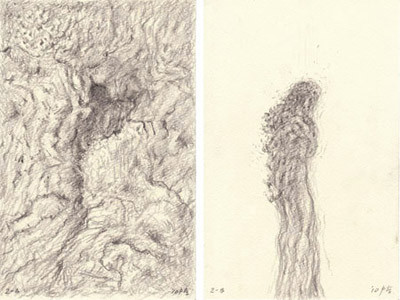Shigeo Toya
08 May - 12 Jun 2010
SHIGEO TOYA
"Minimalbaroque VI"
May 8, Sat., 2010– Jun. 12, Sat., 2010
Closed on Mon., Sun. and holidays
I see reliefs as the starting point. They are neither sculpture nor painting, but have elements of both. They are objectifications of absence. They come before consciousness of the division between three and two dimensions. In saying that reliefs have both elements I mean those two elements are mixed together, undifferentiated. Reliefs therefore possess the latent energy to mutate, or splinter. They represent a state when humans are still inscribed within the world, when humans have not yet been made aware that nature sees them as outsiders.
Shigeo Toya
(From the catalog of the 1st Tokorozawa Biennale of Art "Siding Railroad")
ShugoArts is pleased to present a solo exhibition of new work by Shigeo Toya, "minimalbaroque VI." Toya is well known for wooden sculpture made using a chainsaw. In recent years he has been experimenting with making multiple linear cuts in the wood, which form crease-like patterns. With these creases, the interior and exterior meld into each other, creating intricate forms that Toya refers to as "woods". In this exhibition, Toya attempts a transformation from the archetypal artistic form of relief, which has elements of both sculpture and painting, into sculpture. The work Cave 2010 is two meters high and 1.3 meters across. It has a likeness of a "woods" carved into its front and a human-like figure at the back. There is a hole visible in the middle of the "woods" on the front. When it is viewed from the back, the hole becomes the ear of the human-like figure. By looking at the "woods" scenery, you hear its voice: in other words, to be a viewer is also to be a listener. Toya sees potental in this duality, this idea that a work can be both relief and sculpture. He presents a world where the senses of sight and hearing are one. The exhibition includes four large works, one set of works and drawings related to each of them.
Born 1947 in Nagano Prefecture. In 1988 represented Japan at the 43rd Venice Biennale. In 1995 held a solo exhibition at the Hiroshima City Museum of Contemporary Art. In 2000 participated in the 3rd Gwangju Biennale, where he won the Asia Award. In 2003 won the Agency for Cultural Affairs Art Encouragement Prize for his solo exhibition, "Shigeo Toya: folds, gazes and anima of the woods" at the Aichi Prefectural Museum of Art. In 2009 participated in the Tokorozawa Biennale of Art. Highly respected both at home and abroad for his exploration of the possibilities of a non-Western form of sculpture.
"Minimalbaroque VI"
May 8, Sat., 2010– Jun. 12, Sat., 2010
Closed on Mon., Sun. and holidays
I see reliefs as the starting point. They are neither sculpture nor painting, but have elements of both. They are objectifications of absence. They come before consciousness of the division between three and two dimensions. In saying that reliefs have both elements I mean those two elements are mixed together, undifferentiated. Reliefs therefore possess the latent energy to mutate, or splinter. They represent a state when humans are still inscribed within the world, when humans have not yet been made aware that nature sees them as outsiders.
Shigeo Toya
(From the catalog of the 1st Tokorozawa Biennale of Art "Siding Railroad")
ShugoArts is pleased to present a solo exhibition of new work by Shigeo Toya, "minimalbaroque VI." Toya is well known for wooden sculpture made using a chainsaw. In recent years he has been experimenting with making multiple linear cuts in the wood, which form crease-like patterns. With these creases, the interior and exterior meld into each other, creating intricate forms that Toya refers to as "woods". In this exhibition, Toya attempts a transformation from the archetypal artistic form of relief, which has elements of both sculpture and painting, into sculpture. The work Cave 2010 is two meters high and 1.3 meters across. It has a likeness of a "woods" carved into its front and a human-like figure at the back. There is a hole visible in the middle of the "woods" on the front. When it is viewed from the back, the hole becomes the ear of the human-like figure. By looking at the "woods" scenery, you hear its voice: in other words, to be a viewer is also to be a listener. Toya sees potental in this duality, this idea that a work can be both relief and sculpture. He presents a world where the senses of sight and hearing are one. The exhibition includes four large works, one set of works and drawings related to each of them.
Born 1947 in Nagano Prefecture. In 1988 represented Japan at the 43rd Venice Biennale. In 1995 held a solo exhibition at the Hiroshima City Museum of Contemporary Art. In 2000 participated in the 3rd Gwangju Biennale, where he won the Asia Award. In 2003 won the Agency for Cultural Affairs Art Encouragement Prize for his solo exhibition, "Shigeo Toya: folds, gazes and anima of the woods" at the Aichi Prefectural Museum of Art. In 2009 participated in the Tokorozawa Biennale of Art. Highly respected both at home and abroad for his exploration of the possibilities of a non-Western form of sculpture.

